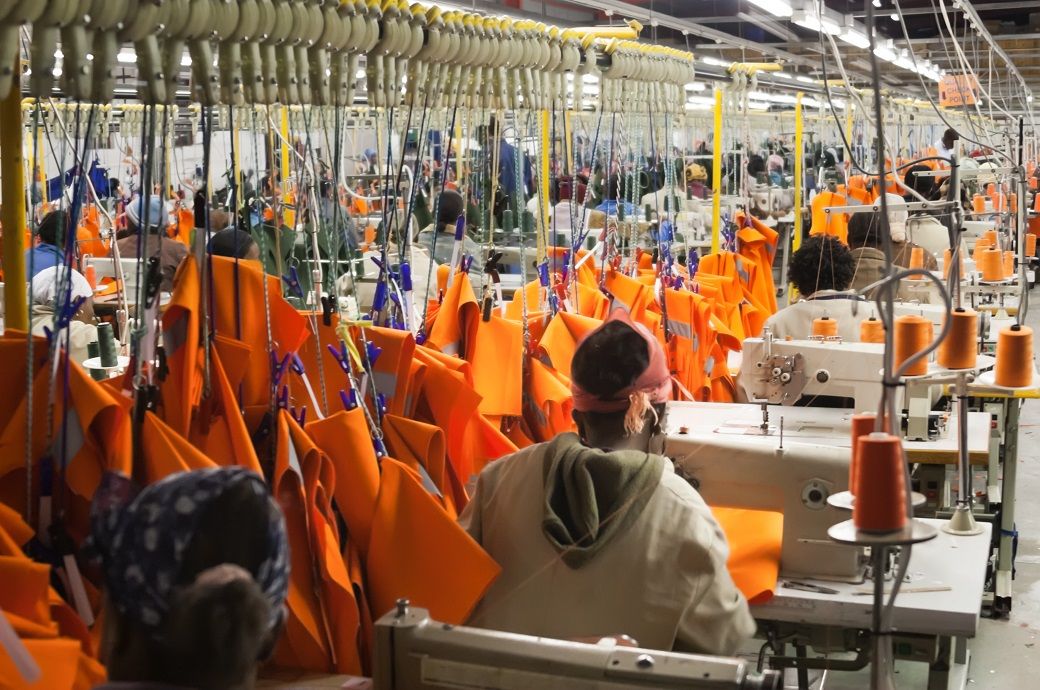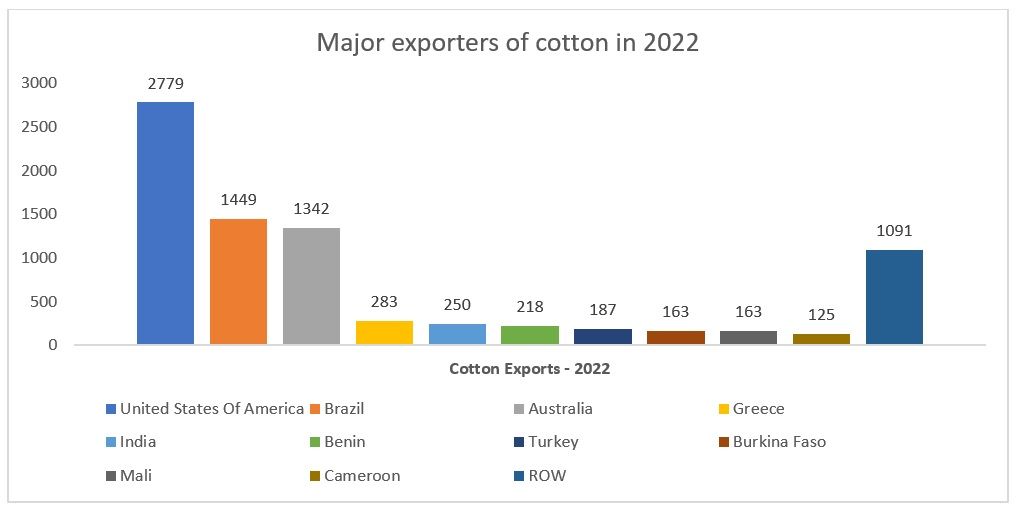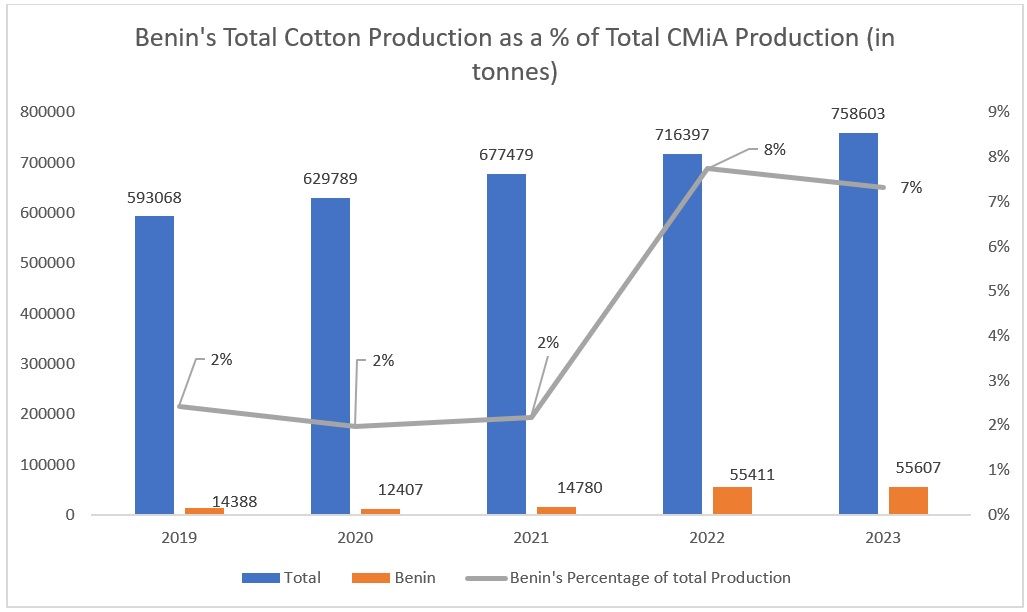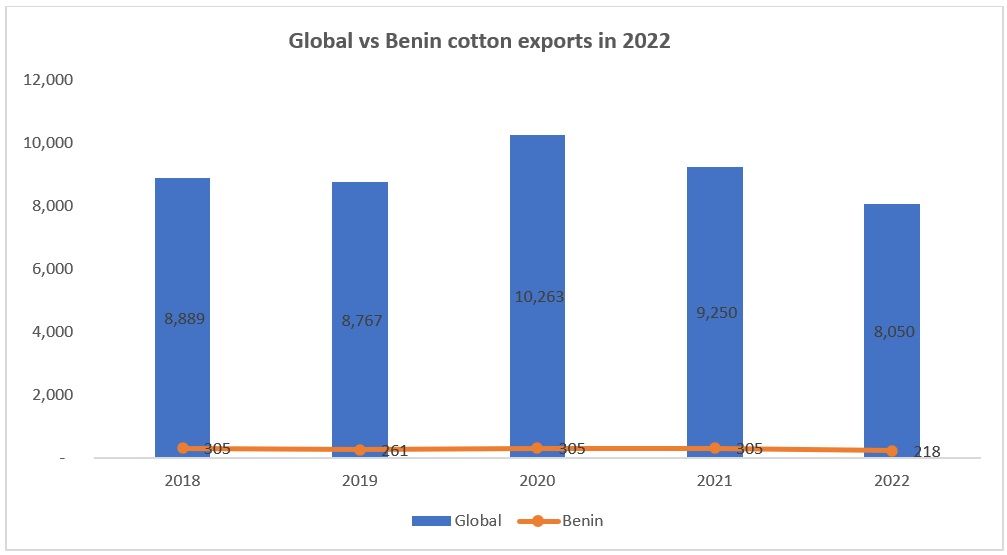
In the global cotton market, Africa contributes 8 per cent of the total cotton production. Notably, 8 out of the 12 highest cotton-producing regions on the continent are in West Africa, also known as Sub-Saharan Africa. This region primarily exports its cotton to countries like Bangladesh and China. Recognising its potential, various organisations have initiated efforts to promote organic cotton production in West Africa. Benin and Burkina Faso are emerging as key players in cotton production, heavily relying on cotton exports.
To further boost their economies, the governments of Benin and Burkina Faso are now spearheading initiatives to manufacture garments using locally produced cotton. This strategic move aims to transform these countries into export hubs for final products like garments, shifting away from raw cotton exports.
Figure 1: Top cotton exporting countries in 2022 (in metric tons)

Source: Statista
Significant work is being carried out by organisations like Cotton Made in Africa (CMiA), a non-profit organisation dedicated to promoting sustainable cotton farming across Africa. This organisation, with a presence across the continent, operates in regions such as Benin, Cote d'Ivoire, and Ghana. As of 2022, CMiA has certified 40 per cent of the cotton produced in the region. The cotton certified by the organisation follows practices that reduce reliance on chemical fertilisers and promote responsible water usage.
In addition to fostering sustainability in cotton production, CMiA also has initiatives to support small-scale farmers, who constitute most of the African agricultural sector. Over the years, the production of CMiA-certified cotton has seen significant growth. Supported by the Aid for Trade foundation, the organisation is focused on promoting sustainable cotton production and encouraging more firms to use CMiA-certified cotton in apparel manufacturing.
Benin is making its mark as one of the emerging cotton hotspots in Africa, with a notable uptick in cotton production within the region. The organisation has been instrumental in advancing cotton cultivation and various socio-economic initiatives. It actively engages in training farmers to adopt sustainable practices, reducing reliance on pesticides, and implementing techniques like crop rotation, hand-picking of cotton, and rain-fed cultivation.
According to CMiA data, the total cotton production using sustainable methods has been steadily increasing since 2019. Figure three illustrates that within the total cotton production using sustainable methods as reported by CMiA, Benin's share has been on the rise. As of 2022, it accounts for 8 per cent of the total production, with a promising outlook for further growth as more farmers join the network.
Figure 2: Cotton production of Benin as a percentage of CMiA production

Source: ICAC Speciality cotton report
Cotton holds immense significance in Benin's local economy, serving as a vital cash crop. This agricultural commodity plays a pivotal role in the country's exports. According to the Food and Agriculture Organization (FAO), cotton exports make up a substantial 33 per cent of the total cotton exports from Benin.
Remarkably, despite being classified as one of the 46 least developed countries by the United Nations, Benin has made significant strides in the cotton sector, thanks to the support of organisations like CMiA. The country's share in cotton production using regenerative methods has been experiencing exponential growth, as depicted in the accompanying graph.
Throughout history, textile industries have consistently served as catalysts for driving a country's economic growth. Africa is no exception to this trend, and many countries are actively working to develop their textile value chains. In this regard, Benin is no different. With its logistical advantages and a growing share of regenerative cotton in the region, Benin possesses the potential to emerge as a prominent hub for the textile industry in the long term. Currently, a significant portion of the raw cotton is exported to Asian garment-producing giants. However, a new initiative is now underway to stimulate the economic prosperity of Benin.
Figure 3: Conventional cotton exports of Benin

Source: UN Comtrade
A strategic partnership between the Republic of Benin and Arise Integrated Industrial Platforms is poised to revolutionise the cotton industry by processing raw cotton domestically and exporting finished garments to African countries, Asia, and the US. This endeavour holds immense potential to significantly boost the local economy, which relies heavily on projects funded by foreign donors and organisations.
Local producers in the country are currently experiencing a surge in demand, with companies like Zara and H&M actively engaging in negotiations with them. As Benin's cotton production aligns more closely with sustainability standards, it is anticipated that more brands will seek collaboration with local producers.
However, there is a risk of many farmers withdrawing from organic and regenerative agriculture due to a lack of marketing and, consequently, insufficient revenue. Initiatives like the one mentioned above are poised to provide invaluable support to these farmers.
Under the joint venture agreement, an integrated textile hub has been established in the Glo-Djigbe Industrial Zone (GDIZ). Currently, the facility employs approximately 200 individuals and produces 8,000 polo T-shirts. Soon, the facility will transition to producing garments using cotton from Benin, proudly bearing the 'Made in Benin' label.
Africa is well on its way to achieving economic growth, and the textile industry is emerging as a key driver of this progress. Organisations such as CMiA are playing a pivotal role in not only enhancing organic cotton production but also fuelling the growth of the textile industry in the region. This strategic move is particularly significant given that a substantial amount of raw cotton is currently being exported to Bangladesh and China. Instead of selling this ‘white gold’, the nation can harness it to foster its own prosperity. After all, why trade gold when it can be used to build our own home?
ALCHEMPro News Desk (MI WE)
Receive daily prices and market insights straight to your inbox. Subscribe to AlchemPro Weekly!